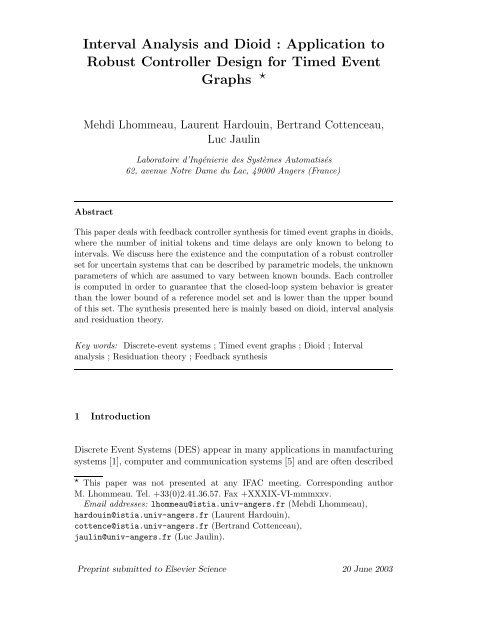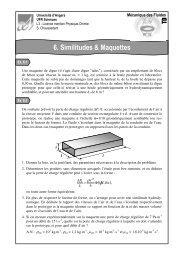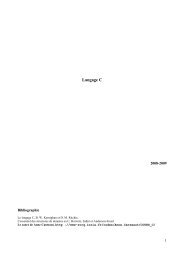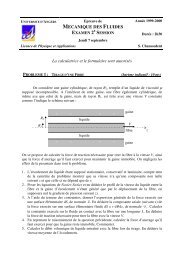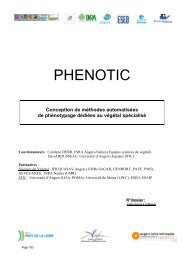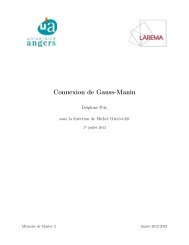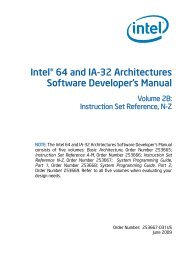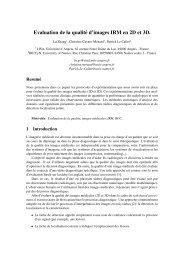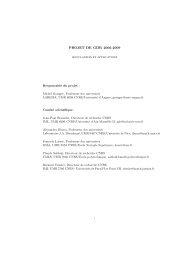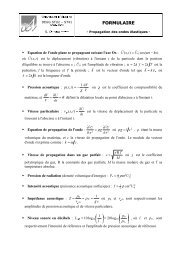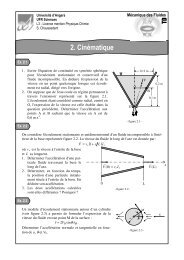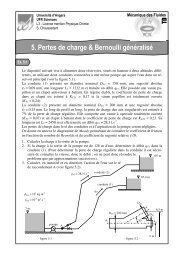Interval Analysis and Dioid : Application to Robust ... - ResearchGate
Interval Analysis and Dioid : Application to Robust ... - ResearchGate
Interval Analysis and Dioid : Application to Robust ... - ResearchGate
Create successful ePaper yourself
Turn your PDF publications into a flip-book with our unique Google optimized e-Paper software.
<strong>Interval</strong> <strong>Analysis</strong> <strong>and</strong> <strong>Dioid</strong> : <strong>Application</strong> <strong>to</strong><strong>Robust</strong> Controller Design for Timed EventGraphs ⋆Mehdi Lhommeau, Laurent Hardouin, Bertr<strong>and</strong> Cottenceau,Luc JaulinLabora<strong>to</strong>ire d’Ingénierie des Systèmes Au<strong>to</strong>matisés62, avenue Notre Dame du Lac, 49000 Angers (France)AbstractThis paper deals with feedback controller synthesis for timed event graphs in dioids,where the number of initial <strong>to</strong>kens <strong>and</strong> time delays are only known <strong>to</strong> belong <strong>to</strong>intervals. We discuss here the existence <strong>and</strong> the computation of a robust controllerset for uncertain systems that can be described by parametric models, the unknownparameters of which are assumed <strong>to</strong> vary between known bounds. Each controlleris computed in order <strong>to</strong> guarantee that the closed-loop system behavior is greaterthan the lower bound of a reference model set <strong>and</strong> is lower than the upper boundof this set. The synthesis presented here is mainly based on dioid, interval analysis<strong>and</strong> residuation theory.Key words: Discrete-event systems ; Timed event graphs ; <strong>Dioid</strong> ; <strong>Interval</strong>analysis ; Residuation theory ; Feedback synthesis1 IntroductionDiscrete Event Systems (DES) appear in many applications in manufacturingsystems [1], computer <strong>and</strong> communication systems [5] <strong>and</strong> are often described⋆ This paper was not presented at any IFAC meeting. Corresponding authorM. Lhommeau. Tel. +33(0)2.41.36.57. Fax +XXXIX-VI-mmmxxv.Email addresses: lhommeau@istia.univ-angers.fr (Mehdi Lhommeau),hardouin@istia.univ-angers.fr (Laurent Hardouin),cottence@istia.univ-angers.fr (Bertr<strong>and</strong> Cottenceau),jaulin@univ-angers.fr (Luc Jaulin).Preprint submitted <strong>to</strong> Elsevier Science 20 June 2003
y the Petri Net formalism. Timed-Event Graphs (TEG) are Timed Petri Netsin which all places have single upstream <strong>and</strong> single downstream transitions <strong>and</strong>appropriately model DES characterized by delay <strong>and</strong> synchronization phenomena.TEG can be described by linear equations in the dioid algebra [2,7] <strong>and</strong>this fact has permitted many important achievements on the control of DESmodelled by TEG [7,8,17,15]. TEG control problems are usually stated in aJust-in-time context. The design goal is <strong>to</strong> achieve some performance whileminimizing internal s<strong>to</strong>cks. In [2,17] an optimal open-loop control law is given.In [8] linear closed-loop controllers synthesis are given in a model matchingobjective, i.e., a given reference model describes the desired performance limits,then the goal is <strong>to</strong> compute a feedback controller in order <strong>to</strong> obtain aclosed-loop behavior as close as possible <strong>to</strong> the reference model <strong>and</strong> <strong>to</strong> delayas much as possible the inputs in the system.This paper aims at designing robust feedback controller when the system includessome parametric uncertainties which can be described by intervals.<strong>Interval</strong>s allow <strong>to</strong> describe TEG with number of <strong>to</strong>kens <strong>and</strong>/or time delays,which are assumed <strong>to</strong> vary between known bounds. Assuming that there existsa lower <strong>and</strong> an upper bound <strong>to</strong> a specification set, the synthesis yields acontroller set which guarantees that the closed loop system behavior is bothgreater than the lower bound of the specification set <strong>and</strong> lower than the upperbound of this same set 1 . Controller synthesis is obtained by consideringresiduation theory which allows the inversion of mapping defined over orderedsets, <strong>and</strong> interval analysis which is known <strong>to</strong> be efficient <strong>to</strong> characterize set ofrobust controllers in a guaranteed way [12].The next Section introduces algebraic <strong>to</strong>ols on dioid <strong>and</strong> residuation theory.Section 3 <strong>and</strong> 4 give the main results, dioid of interval I(D) is constructed <strong>and</strong>mapping inversion over I(D) is addressed. The problem of robust controllersynthesis when the system includes interval parametric uncertainties is stated<strong>and</strong> solved in Sections 5 <strong>and</strong> 6. Section 7 presents an illustrative example.2 <strong>Dioid</strong>s <strong>and</strong> ResiduationA dioid D is a set endowed with two internal operations denoted ⊕ (addition)<strong>and</strong> ⊗ (multiplication), both associative <strong>and</strong> both having neutral elementsdenoted ε <strong>and</strong> e respectively, such that ⊕ is also commutative <strong>and</strong> idempotent(i.e. a ⊕ a = a). The ⊗ operation is distributive with respect <strong>to</strong> ⊕, <strong>and</strong> ε isabsorbing for the product (i.e. ε⊗a = a⊗ε = ε, ∀a). When ⊗ is commutative,the dioid is said <strong>to</strong> be commutative. The symbol ⊗ is often omitted.<strong>Dioid</strong>s can be endowed with a natural order : a ≽ b iff a = a ⊕ b. Then1 From TEG point of view it is a set of robust controller which ensures that thecontrolled system is both slower than a reference model (described as a TEG) <strong>and</strong>faster than another one.2
they become sup-semilattices <strong>and</strong> a ⊕ b is the least upper bound of a <strong>and</strong> b. Adioid is complete if sums of infinite number of terms are always defined, <strong>and</strong> ifmultiplication distributes over infinite sums <strong>to</strong>o. In particular, the sum of allelements of the dioid is defined <strong>and</strong> denoted ⊤ (for ’<strong>to</strong>p’). A complete dioid(sup-semilattice) becomes a lattice by constructing the greatest lower boundof a <strong>and</strong> b, denoted a ∧ b, as the least upper bound of the (nonempty) subse<strong>to</strong>f all elements which are less than a <strong>and</strong> b (see [2, §4]).Example 1 (Z max dioid) The set Z = Z ∪ {−∞, +∞} endowed with themax opera<strong>to</strong>r as sum <strong>and</strong> the classical sum + as product is a complete dioid,usually denoted by Z max , of which ε = −∞ <strong>and</strong> e = 0.Definition 2 (Subdioid) A subset C of a dioid is called a subdioid of D if• ε ∈ C <strong>and</strong> e ∈ C ;• C is closed for ⊕ <strong>and</strong> ⊗.The second statement means, ∀a, b ∈ C, a ⊕ b ∈ C <strong>and</strong> a ⊗ b ∈ C.Remark 3 Obviously a subdioid of a complete dioid may be not complete.Theorem 4 Over a complete dioid D, the implicit equation x = ax⊕b admitsx = a ∗ b as least solution, where a ∗ = ⊕ i∈N a i (Kleene star opera<strong>to</strong>r) witha 0 = e.The Kleene star opera<strong>to</strong>r, over a complete dioid D, will be sometimes representedby the following mapping K : D → D, x ↦→ x ∗ .Theorem 5 ([8]) Let D be a complete dioid <strong>and</strong> a, b ∈ D.a(ba) ∗ = (ab) ∗ a, (1)(a ∗ ) ∗ = a ∗ (2)2.1 Residuation theoryThe residuation theory provides, under some assumptions, optimal solutions<strong>to</strong> inequalities such as f(x) ≼ b where f is an iso<strong>to</strong>ne mapping (f s.t. a ≼b ⇒ f(a) ≼ f(b)) defined over ordered sets. Some theoretical results aresummarized below. Basic references are [4] <strong>and</strong> [2, §4.4.2].Definition 6 (Residual <strong>and</strong> residuated mapping) An iso<strong>to</strong>ne mapping f :D → E, where D <strong>and</strong> E are ordered sets, is a residuated mapping if for ally ∈ E, the least upper bound of the subset {x|f(x) ≼ y} exists <strong>and</strong> belongs <strong>to</strong>this subset. It is then denoted f ♯ (y). Mapping f ♯ is called the residual of f.3
When f is residuated, f ♯ is the unique iso<strong>to</strong>ne mapping such thatf ◦ f ♯ ≼ Id E <strong>and</strong> f ♯ ◦ f ≽ Id D , (3)where Id is the identity mapping respectively on D <strong>and</strong> E.Property 7 Let f : D → E be a residuated mapping, theny ∈ f(D) ⇔ f(f ♯ (y)) = y.Property 8 ([2, Th. 4.56]) If h : D → C <strong>and</strong> f : C → B are residuatedmapping, then f ◦ h is also residuated <strong>and</strong>(f ◦ h) ♯ = h ♯ ◦ f ♯ . (4)Theorem 9 ([2, §4.4.2]) Consider the mapping f : E → F where E <strong>and</strong> Fare complete dioids of which the bot<strong>to</strong>m elements are, respectively, denoted byε E <strong>and</strong> ε F . Then, f is residuated iff f(ε E ) = ε F <strong>and</strong> f( ⊕ x∈G x) = ⊕ x∈G f(x)for each G ⊆ E (i.e f is lower-semicontinuous abbreviated l.s.c.).Corollary 10 The mappings L a : x ↦→ ax <strong>and</strong> R a : x ↦→ xa defined over acomplete dioid D are both residuated. 2 Their residuals are usually denoted,respectively, L ♯ a(x) = a◦\x <strong>and</strong> Ra(x) ♯ = x◦/a in (max, +) literature. 3Theorem 11 ([2, §4.4.4]) The mappings x ↦→ a◦\x <strong>and</strong> x ↦→ x◦/a verify thefollowing properties :(ab)◦\x = b◦\(a◦\x) x◦/(ba) = (x◦/a)◦/b, (5)a ∗ x = a ∗ ◦\(a ∗ x) xa ∗ = (xa ∗ )◦/a ∗ , (6)a◦\(x ∧ y) = a◦\x ∧ a◦\y (x ∧ y)◦/a = x◦/a ∧ y◦/a. (7)Theorem 12 ([18]) Let D be a complete dioid <strong>and</strong> A ∈ D p×n be a matrixwith entries in D. Then, A◦\A is a matrix in D n×n which verifiesA◦\A = (A◦\A) ∗ (8)2.2 Mapping restrictionIn this subsection, the problem of mapping restriction <strong>and</strong> its connection withthe residuation theory is addressed. In particular the Kleene star mapping,2 This property concerns as well a matrix dioid product, for instance X ↦→ AXwhere A, X ∈ D n×n . See [2] for the computation of A ◦\B <strong>and</strong> B◦/A.3 a ◦\b is the greatest solution of ax ≼ b.4
ecomes residuated as soon as its codomain is restricted <strong>to</strong> its image.Definition 13 (Restricted mapping) Let f : E → F be a mapping <strong>and</strong>A ⊆ E. We will denote 4 f |A : A → F the mapping defined by f |A = f ◦ Id |Awhere Id |A : A → E, x ↦→ x is the canonical injection. Identically, let B ⊆ Fwith Imf ⊆ B. Mapping B| f : E → B is defined by f = Id |B ◦ B| f, whereId |B : B → F, x ↦→ x is the canonical injection.Proposition 14 (Canonical injection) Let Id |Dsub : D sub → D be the canonicalinjection from a complete subdioid in<strong>to</strong> a complete dioid. The injectionId |Dsub is residuated <strong>and</strong> its residual will be denoted(Id|Dsub) ♯= Prsub .Remark 15 (Constrained Residuation) The residuation theory providesthe greatest solution of f(x) ≼ b, where f : D → E is an iso<strong>to</strong>ne mapping.The constrained residuation means that we look for the ’approximate’ solutionnot in whole D but only in a subdioid D sub of D.Theorem 16 ([6, §1.3]) Let Id |Dsub the canonical injection from D sub <strong>to</strong> D.Solving f(x) ≼ b amounts <strong>to</strong> solvingf ◦ Id |Dsub (x) ≼ bfor the greatest solution in D sub . If D sub is a complete subdioid, then Id |Dsubresiduated <strong>and</strong> the answer isis(f ◦ Id|Dsub) ♯(b) = (Id|Dsub ) ♯ ◦ f ♯ (b) (thanks <strong>to</strong> Property 8).Definition 17 (Closure mapping) An iso<strong>to</strong>ne mapping f : E → E definedon an ordered set E is a closure mapping if f ≽ Id E <strong>and</strong> f ◦ f = f.Proposition 18 ([8]) Let f : E → E be a closure mapping. A closure mappingrestricted <strong>to</strong> its image Imf| f is a residuated mapping whose residual is thecanonical injection Id |Imf : Imf → E, x ↦→ x.Corollary 19 The mapping ImK| K is a residuated mapping whose residual is(ImK|K ) ♯= Id|ImK .This means that x = a ∗ is the greatest solution <strong>to</strong> inequality x ∗ ≼ a ∗ . Actually,the greatest solution achieves equality.Proposition 20 Let M a : x ↦→ (ax) ∗ a be a mapping defined over a completedioid. Consider g ∈ D <strong>and</strong> d ∈ D. Let us consider the following sets :4 These notations are borrowed from classical linear system theory see [20].5
G 1 = {g | ∃d s.t. g = d ∗ a}, (9)G 2 = {g | ∃d s.t. g = ad ∗ }. (10)ImM a ⊆ (G 1 ∩ G 2 ) <strong>and</strong> the mappings G1 |M a <strong>and</strong> G1 |M a are both residuated.Their residuals are such that ( G 1 |M a) ♯(x) =(G 2 |M a) ♯(x) = a ◦\x◦/a.PROOF. Equation (1) leads <strong>to</strong> (ax) ∗ a = a(xa) ∗ , then by choosing d = axor d = xa, it comes ImM a ⊆ (G 1 ∩ G 2 ) . According <strong>to</strong> Definition 6, we remarkthat the following assertions are equivalent :• G1 |M a is residuated.• ∀d ∈ D, (ax) ∗ a ≼ d ∗ a admits a greatest solution.So, we can concentrate on the second point. Since the mapping L a is residuated(cf. Corollary 10) <strong>and</strong> according <strong>to</strong> (1), we have(ax) ∗ a = a(xa) ∗ ≼ d ∗ a ⇔ (xa) ∗ ≼ a◦\(d ∗ a).According <strong>to</strong> (6) <strong>and</strong> (5), we can rewrite a◦\(d ∗ a) = a◦\(d ∗ ◦\(d ∗ a)) = (d ∗ a)◦\(d ∗ a).According <strong>to</strong> (8), this last expression shows that a◦\(d ∗ a) belongs <strong>to</strong> the imageof K. Since ImK| K is residuated (cf. Corollary 19), there is also the followingequivalence:(xa) ∗ ≼ a◦\(d ∗ a) ⇔ xa ≼ a◦\(d ∗ a).Finally, since R a is residuated <strong>to</strong>o (cf. Corollary 10), we verify that x =a◦\(d ∗ a)◦/a is the greatest solution of (ax) ∗ a ≼ d ∗ a, ∀d ∈ D. That amounts<strong>to</strong> saying that G1 |M a is residuated. We would show that G2 |M a is residuatedwith analog steps. ✷Corollary 21 If g ∈ ImM a , then x = a◦\g◦/a is the greatest solution <strong>to</strong> theequation (ax) ∗ a = g.PROOF. First ImM a ⊆ (G 1 ∩ G 2 ), thus ImMa|M a is residuated. Furthermore,∀y ∈ ImM a , M a (x) = y admits a solution, i.e., ImMa|M a is surjective, then( ImMa|M a ) ♯ provides the greatest solution (see Property 7).6
3 <strong>Dioid</strong> C(D)Consider the set of pairs (x ′ , x ′′ ) with x ′ ∈ D <strong>and</strong> x ′′ ∈ D endowed with twocoordinate-wise algebraic operations :(x ′ , x ′′ ) ∼ ⊕ (y ′ , y ′′ ) = (x ′ ⊕ y ′ , x ′′ ⊕ y ′′ ),(x ′ , x ′′ ) ∼ ⊗ (y ′ , y ′′ ) = (x ′ ⊗ y ′ , x ′′ ⊗ y ′′ ),This set is a dioid denoted C(D) with (ε, ε) as the zero element <strong>and</strong> (e, e) asthe identity element.Remark 22 The operation ∼ ⊕ generates the corresponding canonical partialorder ≼ C in C(D) :(x ′ , x ′′ ) ∼ ⊕ (y ′ , y ′′ ) = (y ′ , y ′′ ) ⇔ (x ′ , x ′′ ) ≼ C (y ′ , y ′′ ) ⇔ x ′ ≼ D y ′ <strong>and</strong> x ′′ ≼ D y ′′where ≼ D is the order relation in D.Proposition 23 ([13]) If the dioid D is complete, then the dioid C(D) iscomplete.Proposition 24 An iso<strong>to</strong>ne mapping f defined over D has a natural extensionin C(D) , f(x ′ , x ′′ ) = (f(x ′ ), f(x ′′ )).Example 25 The Kleene star operation in C(D) is defined by K(x ′ , x ′′ ) =(K(x ′ ), K(x ′′ )) = (x ′∗ , x ′′∗ ).Now we consider the following mappings over C(D) :L (a ′ ,a ′′ ) : (x ′ , x ′′ ) ↦→ (a ′ , a ′′ ) ∼ ⊗ (x ′ , x ′′ ) (left multiplication by (a ′ , a ′′ ));R (a ′ ,a ′′ ) : (x ′ , x ′′ ) ↦→ (x ′ , x ′′ ) ∼ ⊗ (a ′ , a ′′ ) (right multiplication by (a ′ , a ′′ )).Proposition 26 The mappings L (a ′ ,a ′′ ) <strong>and</strong> R (a ′ ,a ′′ ) defined over C(D) areboth residuated. Their residuals are equal <strong>to</strong> L ♯ (a ′ ,a ′′ ) (b′ , b ′′ ) = (a ′ , a ′′ )◦\(b ′ , b ′′ ) =(a ′ ◦\b ′ , a ′′ ◦\b ′′ ) <strong>and</strong> R ♯ (a ′ ,a ′′ ) (b′ , b ′′ ) = (b ′ , b ′′ )◦/(a ′ , a ′′ ) = (b ′ ◦/a ′ , b ′′ ◦/a ′′ ).( ⊕PROOF. Observe that L (a ′ ,a ′′ ) (x ′ ,x )∈X(x ′ , x ′′ ) ) = ⊕ ′′ (x ′ ,x ′′ )∈X L (a ′ ,a ′′ ) (x ′ , x ′′ ),(for every subset X of C(D)), moreover L (a ′ ,a ′′ )(ε, ε) = (a ′ ε, a ′′ ε) = (ε, ε).Then L (a ′ ,a ′′ ) is residuated (thanks <strong>to</strong> Theorem 9). Therefore, we have <strong>to</strong>find, for given (b ′ , b ′′ ) <strong>and</strong> (a ′ , a ′′ ), the greatest solution (x ′ , x ′′ ) for inequality(a ′ , a ′′ ) ⊗ ∼ (x ′ , x ′′ ) ≼ C (b ′ , b ′′ ) ⇔ (a ′ ⊗ x ′ , a ′′ ⊗ x ′′ ) ≼ C (b ′ , b ′′ ), moreoveraccording <strong>to</strong> Remark 22 on the order relation induced by ⊕ on C(D) we have,a ′ ⊗ x ′ ≼ D b ′ <strong>and</strong> a ′′ ⊗ x ′′ ≼ D b ′′ .7
Since the mappings x ′ ↦→ a ′ ⊗ x ′ <strong>and</strong> x ′′ ↦→ a ′′ ⊗ x ′′ are residuated over D(cf. Corollary 10), we have x ′ ≼ D a ′ ◦\b ′ <strong>and</strong> x ′′ ≼ D a ′′ ◦\b ′′ . Then, we obtainL ♯ (a ′ ,a ′′ ) (b′ , b ′′ ) = (a ′ ◦\b ′ , a ′′ ◦\b ′′ ). ✷4 <strong>Dioid</strong> <strong>and</strong> <strong>Interval</strong> Mathematics<strong>Interval</strong> mathematics was pioneered by Ramon E. Moore as a <strong>to</strong>ol for boundingrounding <strong>and</strong> truncation errors in computer programs. Since then, intervalmathematics had been developed in<strong>to</strong> a general methodology for investigatingnumerical uncertainty in numerous problems <strong>and</strong> algorithms, <strong>and</strong> is a powerfulnumerical <strong>to</strong>ol for calculating guaranteed bounds on functions using computers.In [13] the problem of interval mathematics in dioids is addressed. The authorsgive a weak interval extensions of dioids <strong>and</strong> show that idempotent intervalmathematics appears <strong>to</strong> be remarkably simpler than its traditional analog. Forexample, in the traditional interval arithmetic, multiplication of intervals isnot distributive with respect <strong>to</strong> addition of intervals, while idempotent intervalarithmetic keeps this distributivity. Below, we state that residuated theoryhas a natural extension in dioid of intervals.4.1 <strong>Interval</strong> arithmetic in dioidA (closed) interval in dioid D is a set of the form x = [x, x] = {t ∈ D|x ≼ t ≼x}, where (x, x) ∈ C(D), x (respectively, x) is said <strong>to</strong> be lower (respectively,upper) bound of the interval x. In [13] the authors define dioid I(D) endowedwith two coordinate-wise algebraic operations :x − ⊕ y = [x ⊕ y, x ⊕ y] (11)x − ⊗ y = [x ⊗ y, x ⊗ y] (12)where the interval ε = [ε, ε] (respectively, e = [e, e]) is zero (respectively, unit)element of I(D).Since x ⊕ y ≼ x ⊕ y <strong>and</strong> x ⊗ y ≼ x ⊗ y whenever x ≼ x <strong>and</strong> y ≼ y, thenI(D) is closed with respect <strong>to</strong> the operations − ⊕, − ⊗, furthermore zero element<strong>and</strong> unit element of C(D) are in I(D) ; hence I(D) is a subdioid of C(D) (seeDefinition 2). I(D) may be not complete, but can be completed by consideringthe following definition (see [13], [10] <strong>and</strong> [3] for an ordered set <strong>to</strong>pologyintroduction).8
Definition 27 Let {x α } be an infinite subset of I(D), the infinite sum ofelements of this subset is :⊕x α = [ ⊕ααx α , ⊕ αx α ]Remark 28 Note that if x <strong>and</strong> y are intervals in I(D), then x ⊂ y iff y ≼x ≼ x ≼ y. In particular, x = y iff x = y <strong>and</strong> x = y.Remark 29 An interval for which x = x is called degenerate. Degenerate intervalsallow <strong>to</strong> represent numbers without uncertainty. In this case we identifyx with its element by writing x ≡ x.4.2 Residuation of interval linear inequationsProposition 30 The canonical injection Id |I(D) : I(D) → C(D) is residuated.Its residual will be denoted Pr I , i.e.(Id|I(D)) ♯= PrI . (13)PROOF. It is a direct application of Theorem 16, since I(D) is a subdioid ofC(D). The practical computation of Pr I is obtained as follows. Let (x ′ , x ′′ ) ∈C(D), Pr I (x ′ , x ′′ ) = [x, x] = [x ′ ∧ x ′′ , x ′′ ], which is the greatest interval suchthat :x ≼ x ′ , x ≼ x ′′ <strong>and</strong> x ≼ x. ✷Proposition 31 Mapping L a : I(D) → I(D), x ↦→ a − ⊗ x is residuated. Itsresidual is equal <strong>to</strong> L ♯ a(b) = a◦\b = [a◦\b ∧ a◦\b, a◦\b].( −⊕)PROOF. Observe that L a is l.s.c., i.e. L a x∈X x= − ⊕x∈X L a (x), (forevery subset X of I(D)), moreover L a (ε) = L a ([ε, ε]) = [aε, aε] = [ε, ε] = ε.Then L a is residuated (see Theorem 9). By considering result about constrainedresiduation (Theorem 16) <strong>and</strong> since the canonical injection is residuated(Proposition 30), we have(L(a ′ ,a ′′ ) ◦ Id |I(D)) ♯=(Id|I(D)) ♯◦(L(a ′ ,a ′′ )) ♯= PrI ◦ ( L (a ′ ,a ′′ )) ♯. (14)Then by considering b ∈ I(D) ⊂ C(D) the greatest solution in I(D) of A ⊗−x ≼ b is x = A◦\b = [x, x] = [A◦\b ∧ A◦\b, A◦\b]. ✷9
Remark 32 We would show in the same manner that mapping R a : I(D) →I(D), x ↦→ x − ⊗ a is residuated.Remark 33 We have seen that it is possible <strong>to</strong> extend the Kleene star opera<strong>to</strong>rover I(D) (see Example 25). Then ImK| K is also a residuated mapping (seeCorollary 19) whose residual is ( ImK|K ) ♯= Id|ImK . This means that x = a ∗ isthe greatest solution <strong>to</strong> inequality x ∗ = [x ∗ , x ∗ ] ≼ a ∗ = [a ∗ , a ∗ ].5 <strong>Interval</strong> arithmetic <strong>and</strong> Timed Event GraphsIt is well known that the behavior of a TEG can be expressed by linear stateequations over some dioids, e.g., over dioid of formal power series with coefficientsin Z max <strong>and</strong> exponents in Z namely Z max [γ ].X = AX ⊕ BU (15)Y = CX (16)Where X ∈ (Z max [γ ]) n represents the internal transitions behavior, U ∈(Z max [γ ]) p represents the input transitions behavior , <strong>and</strong> Y ∈ (Z max [γ ]) qrepresents the output transitions behavior, <strong>and</strong> A ∈ (Z max [γ ]) n×n , B ∈(Z max [γ ]) n×p <strong>and</strong> C ∈ (Z max [γ ]) q×n represent the link between transitions.We refer the reader <strong>to</strong> [7] for a complete presentation.The class of uncertain systems, which will be considered, are TEG where thenumber of <strong>to</strong>kens <strong>and</strong> time delays are only known <strong>to</strong> belong <strong>to</strong> intervals. Thereforeuncertainties can be described by intervals with known lower <strong>and</strong> upperbounds <strong>and</strong> the matrices of Equations (15) <strong>and</strong> (16) are such that A ∈ A ∈I ( Z max [γ ] ) n×n, B ∈ B ∈ I(Zmax [γ ] ) n×p<strong>and</strong> C ∈ C ∈ I(Zmax [γ ] ) q×n, eachentry of matrices A, B, C are intervals with bounds in dioid Z max [γ ] with onlynon-negative exponents <strong>and</strong> coefficients integer values. By Theorem 4, Equation(15) has the minimum solution X = A ∗ BU. Therefore, Y = CA ∗ BU<strong>and</strong> the transfer function of the system is H = CA ∗ B ∈ H = CA ∗ B ∈I ( Z max [γ ] ) q×p, where H represents the interval in which the transfer functionwill be lie for all the variations of the parameters .Figure 1 shows a TEG with 2 inputs <strong>and</strong> 1 output, which may represent amanufacturing system with 3 machines. Machines M 1 <strong>and</strong> M 2 produce partsassembled on machine M 3 . A <strong>to</strong>ken in dotted lines means that the resourcecan or not <strong>to</strong> be available <strong>to</strong> manufacture part. Durations in bracket gives10
the minimal <strong>and</strong> maximal time spent in the place before contributing <strong>to</strong> theenabling of the downstream transition.For instance, machine M 2 can manufacture 2 or 3 parts <strong>and</strong> each processingtime will last 3 time units. Each manufactured part will spend between 2 <strong>and</strong>6 time units in the downstream place before contributing <strong>to</strong> the enabling oftransition x 3 . Entries A 2,2 = [3γ 3 , 3γ 2 ] <strong>and</strong> A 3,2 = [2, 6] describe the intervalsin which these parameters evolve. Therefore, we obtain the following intervalmatrices,⎛⎞[2γ 2 , 5γ] [ε, ε] [ε, ε]A =⎜ [ε, ε] [3γ 3 , 3γ 2 ] [ε, ε]⎟⎝⎠[3γ, 4γ] [2, 6] [2γ 3 , 3γ]⎛ ⎞[e, e] [ε, ε]B =⎜[ε, ε] [e, e]⎟⎝ ⎠[ε, ε] [ε, ε]()C = [ε, ε] [ε, ε] [e, e] .(17)<strong>and</strong> thanks <strong>to</strong> theorem 3, the transfer function H belongs <strong>to</strong> the interval matrixH given below. It characterizes the whole transfer functions coming from (17):H = CA ∗ B =()[3γ(2γ 2 ) ∗ , 4γ(5γ) ∗ ] [2(3γ 3 ) ∗ , 6(3γ) ∗ ] . (18)6 <strong>Robust</strong> feedback controller synthesisWe consider the behavior of a p-input q-output TEG by a state representationsuch as (15) <strong>and</strong> (16), we focus here on output feedback controller synthesisdenoted F , added between the output Y <strong>and</strong> the input U of the system (seeFigure 2). Therefore the process input verifies U = V ⊕ F Y , <strong>and</strong> the outputis described by Y = H(V ⊕ F Y ). According <strong>to</strong> Theorem 4, the closed-looptransfer relation (depending on F ) is then equal <strong>to</strong>Y = (HF ) ∗ HV. (19)where H ∈ H is the uncertain system transfer.The objective of the robust feedback synthesis is <strong>to</strong> compute a controller Fwhich imposes a desired behavior (a specification) <strong>to</strong> the uncertain system.11
The problem addressed here, consists in computing the greatest interval (inthe sense of the order relation ≼ I(Zmax [γ ]) ), denoted ˆF , which guarantees thatthe behavior of the closed loop system is lower than G ref ∈ I ( Z max [γ ] ) q×p(a specification defined as an interval) for all H ∈ H. Formally the problemconsists in computing the upper bound of the following set{F ∈ I ( Z max [γ ] ) p×q| (HF) ∗ H ≼ G ref } (20)Proposition 34 shows that this problem admits a solution for some referencemodels.Proposition 34 Let M H : I ( Z max [γ ] ) p×q→ I(Zmax [γ ] ) q×p, F ↦→ (HF) ∗ Hbe a mapping. Let us consider the following sets :{G 1 = G ∈ I ( Z max [γ ] ) q×p (| ∃D ∈ I Zmax [γ ] ) }q×qs.t. G = D ∗ H ,{G 2 = G ∈ I ( Z max [γ ] ) q×p (| ∃D ∈ I Zmax [γ ] ) }p×ps.t. G = HD∗.If G ref ∈ G 1 ∪ G 2 , there exists a greatest F such that M H (F) ≼ G ref , givenby⊕ˆF =F = H◦\G ref ◦/H (21){F∈ I(Z max [γ ]) p×q | (HF) ∗ H≼G ref }PROOF. Direct from Proposition 20.✷Below, we consider the robust controllers set, denoted F, such that the transferof the closed loop system be in G ref for all H ∈ HF = {F ∈ Z max [γ ] p×q | (HF ) ∗ H ⊂ G ref }Corollary 35 If G ref ∈ ImM H , then ˆF ⊂ F.PROOF. If G ref ∈ ImM H , then M H (ˆF) = G ref thanks <strong>to</strong> Corollary 21, thus(HˆF) ∗ H ⊂ G ref . Obviously, this is equivalent <strong>to</strong> ∀F ∈ ˆF, (HF ) ∗ H ⊂ G ref ,which leads <strong>to</strong> the result. ✷Corollary 35 shows that if G ref ∈ ImM H each feedback controller F ∈ ˆF isalso in F. From a practical point of view this means that for all number of<strong>to</strong>kens <strong>and</strong> holding time belonging <strong>to</strong> the given interval the closed loop system12
will be in the specification interval.Corollary 36 If G ref ∈ ImM H , then the upper bound of the interval ˆF, denotedˆF , is the upper bound of the set F.PROOF. Corollary 35 yields (HˆF) ∗ H = G ref , i.e., [(H ˆF ) ∗ H, (H ˆF ) ∗ H] =[G ref , G ref ]. Furthermore G ref ∈ ImM H implies that there exists F suchthat G ref = (HF ) ∗ H, i.e., G ref ∈ ImM H then thanks <strong>to</strong> corollary 21 ˆF =H◦\G ref ◦/H is the greatest feedback such that G ref = (H ˆF ) ∗ H, thus the greatestfeedback in F.Remark 37 From a computational point of view we haveˆF = H ◦\G ref ◦/H = [H, H] ◦\[G ref , G ref ]◦/[H, H] = [H ◦\G ref ∧ H ◦\G ref , H ◦\G ref ]◦/[H, H]= [(H ◦\G ref ∧ H ◦\G ref )◦/H ∧ H ◦\G ref ◦/H, H ◦\G ref ◦/H]= [H ◦\G ref◦/H ∧ H ◦\G ref ◦/H ∧ H ◦\G ref ◦/H, H ◦\G ref ◦/H]thanks <strong>to</strong> (7).The last equation may be simplified, indeed (H ◦\G ref )◦/H ≽ (H◦\G ref )◦/H thanks<strong>to</strong> the anti<strong>to</strong>ny of mapping a◦/x (i.e., x 1 ≽ x 2 ⇒ a◦/x 1 ≼ a◦/x 2 ), then H◦\G ref ◦/H∧H◦\G ref ◦/H = H◦\G ref ◦/H. ThereforeˆF = H◦\G ref ◦/H = [H◦\G ref◦/H ∧ H◦\G ref ◦/H, H◦\G ref ◦/H]. (22)7 Example : Output Feedback synthesisWe describe a complete synthesis of a controller for the uncertain TEG depictedwith solid black lines in Fig. 1. The reference model chosen is( ( )) ∗γ 2G ref = H Hγ(2 )= [3γ ⊕ 5γ 3 (1γ) ∗ , 4γ(5γ) ∗ ] [2 ⊕ (4γ 2 )(1γ) ∗ , 6 ⊕ 9γ ⊕ 12γ 2 ⊕ 15γ 3 ⊕ 18γ 4 ⊕ 21γ 5 ⊕ 25γ 6 (5γ) ∗ ] .This specification means that not more than two <strong>to</strong>kens can input in theTEG at the same moment. We refer the reader <strong>to</strong> [8,?] for a discussion aboutreference model choice. We aim <strong>to</strong> compute the greatest interval of robustcontrollers which keep the same objective.According <strong>to</strong> Proposition 34 <strong>and</strong> solution (21), the controller is obtained by13
computing H◦\G ref ◦/H. Therefore we obtain⎛⎞⎜[−3γˆF −1 ⊕ −1γ(1γ) ∗ , −15γ −1 (5γ) ∗ ]⎟= ⎝⎠[−2 ⊕ γ 2 (1γ) ∗ , −6 ⊕ −3γ ⊕ γ 2 ⊕ 3γ 3 ⊕ 6γ 4 ⊕ 9γ 5 ⊕ 13γ 6 (5γ) ∗ ]For the realization of that controller it is necessary <strong>to</strong> choose one feedback inthe set ˆF. Here we choose the lower bound of this set, i.e.,ˆF = ( −3γ −1 ⊕ −1γ(1γ) ∗− 2 ⊕ γ 2 (1γ) ∗) tThis feedback is not causal because there are negative coefficients in matrixentries meaning negative date for the transition firings (see [2] for a strictdefinition of causality in dioid). The canonical injection from the set of causalelements of Z max [γ ] (denoted Z + max [γ ]) in Z max [γ ] is also residuated (see [8]for details). Its residual is denoted Pr + , therefore the greatest causal feedbackisˆF + = Pr + ( ˆF ) =⎛ ⎞⎜⎝ γ2 (1γ) ∗ ⎟⎠ . (23)γ 2 (1γ) ∗Figure 1 shows one realization of the controller (bold dotted lines).Remark 38 The reader can find software <strong>to</strong>ols in order <strong>to</strong> h<strong>and</strong>le periodicseries <strong>and</strong> solve the illustration (see [19]).8 ConclusionIn this paper we have supposed that the TEG includes some parametric uncertaintiesin a bounded context. We have given a robust feedback controllersynthesis which ensures that the closed-loop system transfer is in a given intervalfor all feasible values for the parameters. The next step is <strong>to</strong> extend thiswork <strong>to</strong> other control structure such as the one given in [16]. The traditionalinterval theory is very effective for parameter estimation, it would be interesting<strong>to</strong> apply the results of this paper <strong>to</strong> the TEG parameter estimation suchas intended in [11].14
References[1] H. Ayhan <strong>and</strong> M.A. Wortman. Job flow control in assembly operations. IEEETransactions on Au<strong>to</strong>matic Control, 44(4):864–868, 1999.[2] F. Baccelli, G. Cohen, G.J. Olsder, <strong>and</strong> J.P. Quadrat. Synchronization <strong>and</strong>Linearity : An Algebra for Discrete Event Systems. Wiley <strong>and</strong> Sons, 1992.[3] J. Betrema. Topologies sur des espaces ordonnés. R.A.I.R.O. InformatiqueThéorique, 16(2):165–182, 1982.[4] T.S. Blyth <strong>and</strong> M.F. Janowitz. Residuation Theory. Pergamon press, 1972.[5] J.-Y Le Boudec <strong>and</strong> P. Thiran. Network Calculus. Springer Verlag, 2002.[6] G. Cohen. Residuation <strong>and</strong> applications. Algèbres Max-Plus et applicationsen informatique et au<strong>to</strong>matique, Ecole de printemps d’informatique théorique,1998.[7] G. Cohen, P. Moller, J.P. Quadrat, <strong>and</strong> M. Viot. Algebraic Tools for thePerformance Evaluation of Discrete Event Systems. IEEE Proceedings: Specialissue on Discrete Event Systems, 77(1):39–58, January 1989.[8] B. Cottenceau, L. Hardouin, J.-L. Boimond, <strong>and</strong> J.-L. Ferrier. Model ReferenceControl for Timed Event Graphs in <strong>Dioid</strong>. Au<strong>to</strong>matica, 37:1451–1458, August2001.[9] S. Gaubert. Resource Optimization <strong>and</strong> (min,+) Spectral Theory. IEEE Trans.on Au<strong>to</strong>matic Control, 40(11), November 1995.[10] M. Gondran <strong>and</strong> M. Minoux. Graphes, dioïdes et semi-anneaux : Nouveauxmodèles et algorithmes. Paris, Tec & Doc edition, 2001.[11] L. Jaulin, J.-L. Boimond, <strong>and</strong> L. Hardouin. Estimation of discrete event systemsusing interval computation. Reliable Computing, 5:165–173, 1999.[12] L. Jaulin, M. Kieffer, O. Didrit, <strong>and</strong> E. Walter. Applied <strong>Interval</strong> <strong>Analysis</strong> withExamples in Parameter <strong>and</strong> State Estimation, <strong>Robust</strong> Control <strong>and</strong> Robotics.Springer-Verlag, London, 2001.[13] G.-L. Litvinov <strong>and</strong> A.-N. Sobolevskii. Idempotent <strong>Interval</strong> <strong>Analysis</strong> <strong>and</strong>Optimization Problems. Reliable Computing, 7(5), 2001.[14] G.L. Litvinov, V.P. Maslov, <strong>and</strong> A.N. Sobolevskii. Idempotent Mathematics<strong>and</strong> <strong>Interval</strong> <strong>Analysis</strong>. (math.NA/9911126), February 2001. Available fromhttp://arXiv.org.[15] R. Lüders <strong>and</strong> R. San<strong>to</strong>s-Mendes. Generalized Multivariable Control of DiscreteEvent Systems in <strong>Dioid</strong>. Worshop on Discrete Event Systems, WODES’02,Zaragoza, 2002.15
[16] C.-A. Maia, L. Hardouin, R. San<strong>to</strong>s-Mendes, <strong>and</strong> B. Cottenceau. Optimalclosed-loop control of timed-event graphs in dioids. To appear in IEEETransactions on Au<strong>to</strong>matic Control.[17] E. Menguy, J.-L. Boimond, L. Hardouin, <strong>and</strong> J.-L. Ferrier. Just in Time Controlof Timed Event Graphs: Update of Reference Input, Presence of UncontrollableInput. IEEE Trans. on Au<strong>to</strong>matic Control, 45(11):2155–2158, November 2000.[18] Max. Plus. Second Order Theory of (Min,+)-linear Systems <strong>and</strong> its <strong>Application</strong><strong>to</strong> Discrete Event Systems. In Proceedings of the 30th CDC, Brigh<strong>to</strong>n, Engl<strong>and</strong>,December 1991.[19] SW2001. Software Tools for Manipulating Periodic Series. http://www.istiaangers.fr/˜hardouin/outils.html,http://amadeus.inria.fr/gaubert/papers/max.html., 2001.[20] W. Wonham. Linear multivariable control : A geometric approach, 3rd edition.Springer Verlag, 1985.16
AIntroductionB<strong>Dioid</strong>s <strong>and</strong> ResiduationB.1 Residuation theoryB.2 Mapping restrictionC<strong>Dioid</strong> C(D)D<strong>Dioid</strong> <strong>and</strong> <strong>Interval</strong> MathematicsD.1 <strong>Interval</strong> arithmetic in dioidD.2 Residuation of interval linear inequationsE<strong>Interval</strong> arithmetic <strong>and</strong> Timed Event GraphsF<strong>Robust</strong> feedback controller synthesisGExample : Output Feedback synthesisHConclusion17
87.0;Fig. 1. A uncertain TEG with a controller (bold dotted lines)Fig. 2. An uncertain system with a feedback controller18


